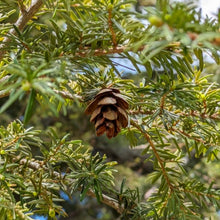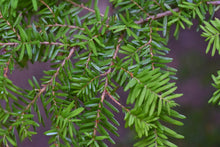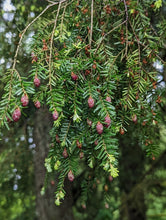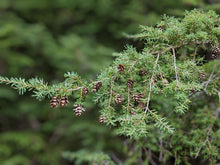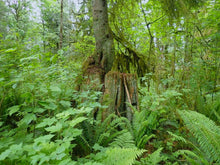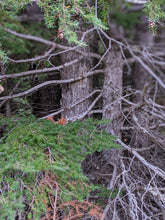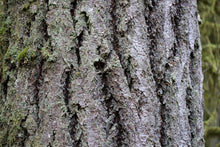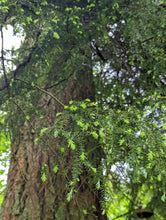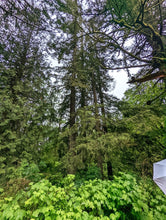
Tsuga heterophylla
Western hemlock is an attractive, large canopy tree with graceful, evergreen foliage and a distinctive, drooping leader tip. In May and June, it prolifically grows papery, light brown male and female cones. Male cones are exceptionally small, usually less than ¼”, while females are up to 1” and egg-shaped. Female cones release their seeds in fall, much to the delight of countless species of birds and mammals. The feathery bows also provide excellent cover for wildlife.
- Plant type/canopy layer: evergreen, perennial, large tree
- Size at maturity: 50-200' tall, trunk grows incrementally over decades until eventually reaching 25-40' wide when it’s 1000 years old (literally!)
- Light requirements: full shade, part sun/part shade
- Moisture requirements: moist to dry soil (but prefers moist)
- Bloom time: cones develop in May - June (then mature throughout summer and disperse seed in September/October)
- Growth rate/ease: slow growing, moderately easy to grow
- Wildlife support: seeds are an important food source for chickadees, siskins and crossbills; bark is eaten by native squirrels, porcupines and other mammals; foliage and twigs are eaten by deer and elk; overall plant is a caterpillar host plant and larval food source for around 50 species of native moths and butterflies, supports countless species of beneficial and pest-eating insects, and is a favorite nesting tree for many birds
- Native habitat/range: commonly found in moist, deep forests, at elevations below 1000m, from the west Cascades to the coast, northern California to southwestern Alaska, as well as the Rocky Mountains of Canada, Montana and Idaho. Portland Plant List - yes.
- Special features & uses: evergreen; wildlife favorite; landscape uses include woodland gardens, erosion control and screens; the inner cambium is edible in winter as a survival food and branch tips can also be used to flavor meat and stave off starvation; medicinally, the needles can be chewed and used for burns, a decoction of pounded bark has been used to treat tuberculosis, an infusion of bark used to treat hemorrhage, and pitch can be used to prevent chapping and sunburn and to heal abrasions; other human uses include using bough as temporary shelters and to wrap/cover food in earthen ovens and making the bark into a brown dye for fishing nets and to smoke hides. The wood makes excellent firewood and building material for tools, masks, dishware, and utensils. Today, western hemlock continues to be used for timber and paper.
Gardening with Western Hemlock: This slow-growing and long lived giant typically sprouts up, in the shade of earlier succession species, often on nurse logs or other loamy soils that are moist and rich in humus. So, when you happen upon them in the forest, it often indicates you’re in a relatively ancient and healthy place. Breathe deep and cherish it.
Bringing this tree into a habitat garden requires moist, well-drained soils rich in organic matter. It will grow slowly in full shade, and more quickly with a little sunshine. When it’s given the right conditions, and the space and time to thrive, it can easily become one of the most cherished trees for humans and wildlife alike.
Companion Plants: Plant with species that thrive together in moist forests of the Pacific Northwest. In the small tree and shrub layer, try vine maple (Acer circinatum), Cascade Oregon grape (Berberis nervosa), osoberry (Oemleria cerasiformis), thimbleberry (Rubus parviflorus) and red elderberry (Sambucus racemosa var. arborescens). Then layer in tons of ferns, bleeding heart (Dicentra formosa), vanillaleaf (Achlys triphylla), candyflower (Claytonia sibirica), starry soloman's seal (Maianthemum stellata), Oregon oxalis (Oxalis oregana), piggyback plant (Tolmiea menziesii), Western trillium (Trillium ovatum), insideout flower (Vancouveria hexandra) and streambank violet (Viola glabella) in the herbaceous layer.
Photo Credit 1 (cone closeup): © Sandy Robertson, some rights reserved (CC-BY)
Photo Credit 2 (needles closeup): © Don Loarie, some rights reserved (CC-BY)
Photo Credits 3, 8, 9 (boughs, trunk, mature habit): © Dominic Gentilcore, some rights reserved (CC-BY)
Photo Credit 4 & 6 (branch, bare trunks): © David Anderson, some rights reserved (CC-BY)
Photo Credit 5 (growing out of stump): © John Brew, some rights reserved (CC-BY)
Photo Credit 7 (mature bark): © jimsox, some rights reserved (CC-BY)









